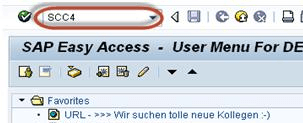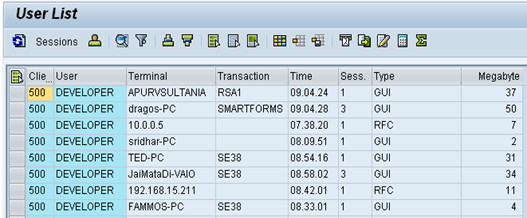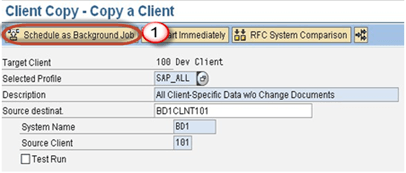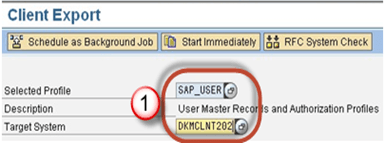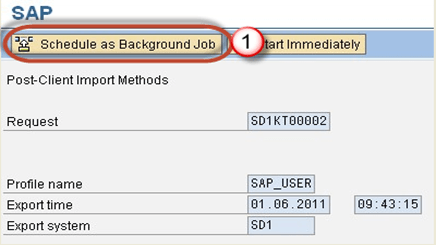Users Online
· Members Online: 0
· Total Members: 188
· Newest Member: meenachowdary055
Forum Threads
Latest Articles
Articles Hierarchy
SAP Basis
What is Client? How to Create a New Client in SAP SCC4
What is a SAP Client?
Client is a 'Customer'. in SAP. We can say that each customer maps to one client. Within one SAP instance, a number of Clients can be created. No need to install separate softwares for each and every customer.It provides isolation ,one client cannot see the data of another client.
As depicted above 100 and 200 clients exist under one roof. We can create a number of clients in SAP Application (from 000 to 999)
What does client contain?
-
Application Data- Application data is the data that are stored in the database tables.
- Customizing Data - Customizing data is data created by customers when they customize their systems
- User Master Record- A user master record defines the authorizations assigned to a user. Basis consultants are responsible for maintaining the user master record and assigning authorizations.
Advantages of Client concept: -
- Clients enable SAP SAS providers to install a small number of SAP Systems, but still cater to a large number of customers.
- Costs are not only saved by sharing hardware and software but multiple customers also use the same application solution, including administration and support.
- Clients help establish your SAP landscape. For instance, you can have a client for the development team, a client for a test team and a production client.
SAP comes with three "standard clients": -
- 000
- 001
- 066
000 Client: - We can find this clients in the system as soon as we install SAP r/3 software. This is called master client. Client 000 contains a simple organizational structure of a test company and includes parameters for all applications, standard settings, and configurations for the control of standard transactions and examples to be used in many different profiles of the business applications. It contains client independent data.
001 Client: - This clients is a copy of the 000 client including the test company. This client's settings are client-independent if it is configured or customized. People normally use 001 clients to create a new client.
066 Client: - This client is called early watch client. The SAP earlywatch alert is a diagnosis service, for solution monitoring of SAP and non-SAP systems in the SAP Solution Manager. Alert may contain Performance issue, average response time, current system load, Database administration,etc..
How to create a new client?
Theoretically, we can create clients from 000 to 999.But maintenance of such a large number of clients becomes a challenge.
Step 1) Execute T-Code SCC4
Step 2) It will bring you to the initial screen of SAP clients.
Click New Entry to make a new SAP Client
Step 3)
- Enter basic details as given below.
- Client number & description
- City to which client Belongs (etc, NY-New York)
- Logical system may be <SID>CLNT<Client Number>
- Std Currency may be (etc EUR)
- Client roles may be Customizing, Demo, Training/Education, Production, etc..
- Enter your client specific data and set permission for the clients as per your requirement
- Save
- Press F3 to come back to SCC4
Step 4) New client will be there in the list.Here we have created client 100.
SAP Client Copy: Local, Remote, Import/Export
Client Copy
We can generate a blank client with SCC4.But how to fill the data in the client?"Answer is the client copy."
Client copy means "transferring client specific data" within the same instance(SID) or between different instances(SID).
Client copy can be performed with three different methods -
- Local client copy.
- Remote client copy.
- Client Import/Export.
Below brief details are given about client copy methods.
Local Client Copy: - This method is used to copy client within the same instance (SID).It is done by T-code SCCL.
Remote Client Copy: -This method is used to copy client between different instances(SID).It is performed by T-code SCC9.
Client Import/Export: - This method is used to copy client between different instances(SID).It is performed by T-code SCC8
Client Copy Pre-steps
To avoid data inconsistencies there are few pre-steps to be performed before starting client copy:-
1) Disconnect and lock business users(SU10).You can end the session of active users in the system through SM04. Once all users are logged out, check that no canceled or pending update requests exist in the system.
2) Suspend all background jobs
- Execute SE38 as given below.
- Fill program name with "BTCTRNS1" as above figure.
- Press Execute.
3) For a local copy, the system must have enough space in the database or tablespace.
For remote copy, target system must have enough space in the database or tablespace. Check space using Tx DB02.
4) To avoid inconsistencies during client copy users should not be allowed to work in source client.
5) rdisp/max_wprun_time parameter should be changed to 2000 second as a SAP recommendation . Although you use parallel processes and schedule job in the background, dialog processes will be used.
Local Client Copy
Local client copy is performed using Tcode SCCL.
Scenario:-
- Source Instance & client := DKM-000
- Target Instance & client := DKM-202
Step 1) Create an entry for your new target client using SCC4. In our scenario, we will create client 202 in DKM system.Log on to this newly created target client (DKM-202) with user SAP* and default password pass.
Step 2) Excute T-code SCCL.
Step 3)
- Select your desired profile
- Enter Source client.
- Enter Description
Step 4) By default Client Copy is executed as a single process. A Single process will take a lot of time. We will distribute the workload of single the process to parallel(multiple) processes which will reduce time in copying a client.
- Select Goto from the menubar.
- Select Parallel Process.Parallel processes are used to exploit the capacity of database better
Step 5) Always execute long running processes in background mode rather than foreground/dialog mode. In fact, some processes run more quickly in the background.
Step 6) The client copy logs are available in SCC3. Status - "Successfully Completed" means client copy is completed.
Remote Client Copy:-
This technique uses Remote function call. You can view RFC from SM59. This technique depends on the network, so network connectivity must be strong enough.
Scenario:-
Source Instance & client := BD1-101
Target Instance & client := DKM-202
Step 1) Log on to the target system. Here we will log on to DKM system. Create a new target client entry(202) using SCC4. Log on to this new target client with user SAP* and default password "pass".Here we will log on to DKM-200 system.
Step 2) Execute Transaction Code SCC9.
Step 3) Fill the basic details as per your requirement.
Step 4) Select Parallel Process.Parallel processes are used to exploit the capacity of database better.
Step 5) Schedule the client copy in background
Step 6) The client copy logs are available in SCC3 as given below.
Client Import/Export
For large database, it is recommended to use client import/export instead of remote client copy.
Scenario:-
Source Instance & client := PKT-300
Target Instance & client := DKM-202
This technique always starts with client export step.
Note: - You must have enough space in the /usr/sap/trans_SID file system to perform the client export.
How to export client?;
Step 1) Log on to the target system(DKM). Create an entry for your new target client using SCC4. Log on to the source system/source client(PKT).
Step 2)Before you import a Client you need to export.Export is nothing but transferring data files and co-files from source system's database to target system's import buffer.Execute T-code SCC8.
Step 3)
- Select profile
- Choose target system.
Step 4) Schedule the export in background
Step 5) Once the job is executed data files and co-files of profiles from PKT system's database are transferred to DKM system's import buffer.Once we will import request in DKM only then it will be reflected in a database of DKM system.
Depending on the chosen export profile there can be up to 3 transport requests created:
- Request PKTKO00151 will hold the cross-client data,
- Request PKTKT00151 will hold the client dependent data,
- Request PKTKX00151 will also hold some client dependent data.
How to import the client?
Step 1) Log on to the newly created target client(DKM-202) using SAP* and password pass.
Step 2) Start the STMS_IMPORT transaction
As shown below, import queue will open
Step 2) Select the transport requests generated by client export .Import theses transport requests on the target client.
The transport requests should be imported in the following sequence:
- Request PKTKO00151
- Request PKTKT00151
- Request PKTKX00151
The system automatically detects these are client export transport requests and automatically performs the import of the 3 requests.
The import logs can be seen in STMS_IMPORT.
Step 3) Post import phase:-
Once the import is done, execute SCC7 to perform the post client import actions,
Schedule the post import job in background.
Step 4) Import log will be available in SCC3. The Client is successfully imported.


